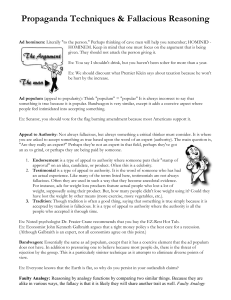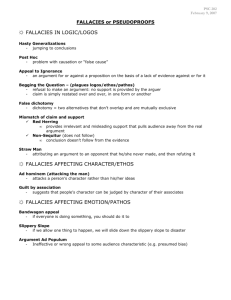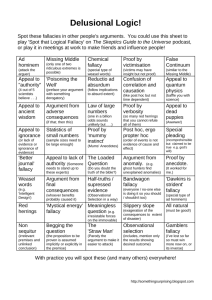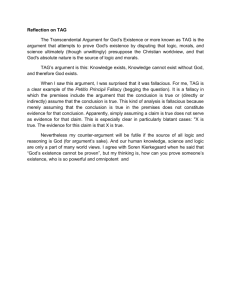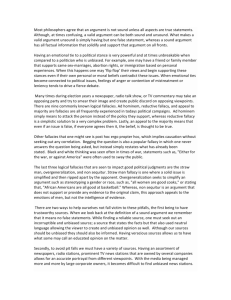Why Is The Ad Populum A Fallacy? Douglas N
advertisement
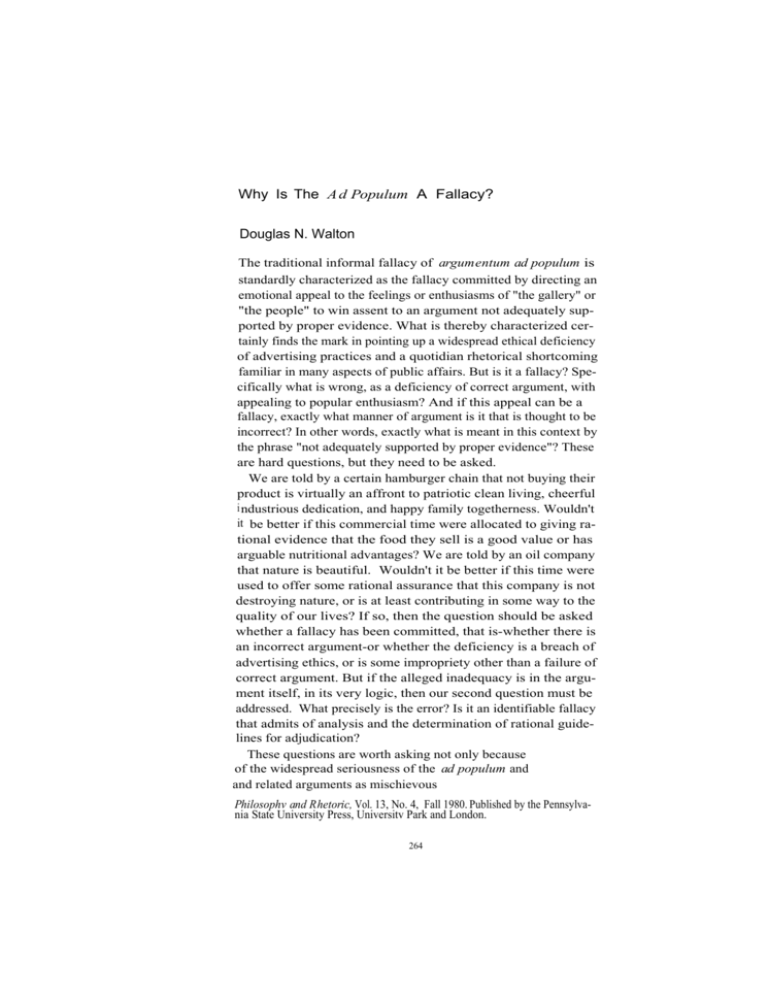
Why Is The Ad Populum A Fallacy? Douglas N. Walton The traditional informal fallacy of argumentum ad populum is standardly characterized as the fallacy committed by directing an emotional appeal to the feelings or enthusiasms of "the gallery" or "the people" to win assent to an argument not adequately supported by proper evidence. What is thereby characterized certainly finds the mark in pointing up a widespread ethical deficiency of advertising practices and a quotidian rhetorical shortcoming familiar in many aspects of public affairs. But is it a fallacy? Specifically what is wrong, as a deficiency of correct argument, with appealing to popular enthusiasm? And if this appeal can be a fallacy, exactly what manner of argument is it that is thought to be incorrect? In other words, exactly what is meant in this context by the phrase "not adequately supported by proper evidence"? These are hard questions, but they need to be asked. We are told by a certain hamburger chain that not buying their product is virtually an affront to patriotic clean living, cheerful i ndustrious dedication, and happy family togetherness. Wouldn't it be better if this commercial time were allocated to giving rational evidence that the food they sell is a good value or has arguable nutritional advantages? We are told by an oil company that nature is beautiful. Wouldn't it be better if this time were used to offer some rational assurance that this company is not destroying nature, or is at least contributing in some way to the quality of our lives? If so, then the question should be asked whether a fallacy has been committed, that is-whether there is an incorrect argument-or whether the deficiency is a breach of advertising ethics, or is some impropriety other than a failure of correct argument. But if the alleged inadequacy is in the argument itself, in its very logic, then our second question must be addressed. What precisely is the error? Is it an identifiable fallacy that admits of analysis and the determination of rational guidelines for adjudication? These questions are worth asking not only because of the widespread seriousness of the ad populum and and related arguments as mischievous Philosophv and Rhetoric, Vol. 13, No. 4, Fall 1980. Published by the Pennsylvania State University Press, Universitv Park and London. 264 DOUGLAS N. WALTON 265 fallacies in practices of the manipulation of public opinion, but because there is a positive and constructive need to understand the fallacies, how they work, and when and why they are wrong. For a faith in the power of argument as an ally of truth and correct argument is the mainstay of our democratic political institutions, and our adversary legal system. But in order to understand argument there is the scholarly requirement to bring some order to the study of the informal fallacies as a coherent discipline of logic and philosophy. Students often perceive this need to understand the fallacies, but as Hamblin (1970) has pointed out, the Standard Treatment largely fails to offer adequate theory to aid us in classifying putatively fallacious arguments into correct and incorrect cases. Too often, a putative fallacy like the ad verecundiam turns out to have instances that seem to be after all correct, even if the precise model of argument of which the cited example is a correct instance turns out to be elusive. Yet as John Woods and I have argued (1974), (1976), a fallacy, if it is to command our interest as an incorrect argument, must be more than a mere behavioral aberration, or a shortcoming of persuasiveness, manners. or morals. It must be a wrong argument. A main problem is that once it is perceived that the model of argument involved in an informal fallacy is not that of classical first-order logic, the move is either to dismiss the study of the fallacy as of no interest to the proper subject of logic, or to insist that "informality" must signal the complete inappropriateness of any structured decision mechanisms of any "formal" sort. Hence the stultifying bifurcation between formal logic and the study of informal fallacies that has resulted in the Standard Treatment. In this essay 1 will try to indicate how that impasse should be overcome in the case of the ad populum, by arguing that formal mechanisms are involved, but that the logic involved is not standard, and that the role of extra-logical components must also be brought in and integrated with the formal elements. Thus it will be shown that what informality is involved need not require the entire avoidance of logical structures. Quite to the contrary. But the structures involved will not be those of classical logic. 266 WHY IS THE AD POPULUM A FALLACY? 1. Arguments Directed to Specific Recipients. Perhaps what initially seems most wrong or fallacious about the use of the ad populum is that such an argument is directed to a specific group of actual persons rather than being an attempt to argue from true premisses. In arguing ad populum, when one selects premisses, it matters little whether the premisses are true. The question is rather one of whether these premisses are plausible and will be accepted-if possible, enthusiastically-by the audience that is being confronted. The fallacy here would be that of throwing concern for the truth aside in favor of an outright partisan process of trying to convince by utilizing whatever assumptions, no matter how outrageous, that one's target audience seems prepared to tolerate. What seems wrong is that one's argument is allowed to be subjectively oriented, person-relative, and therefore it subverts the objective goal of arriving at the truth by the process of logical reasoning. In this connection there seems a clear parallel between the ad populum and the ad hominem.1 The main difference is that whereas the ad populum is directed toward the group, the ad hominem is directed toward one individual. Of course there is a difference or orientation in that the ad hominem is negative in its intent to discredit the individual, whereas the ad populum is positive in its intent to win the approval of the group. But the subjective element is common to both. However, the above explanation of what is fallacious about the ad populum is i ncorrect, insofar as it rests on the assumption that the only worthwhile and legitimate function of argument is to reason from true premisses-that is, to produce sound arguments. In my view, a properly broad and dialectical perspective on the concept of argument and its uses adequate to the study of the fallacies should include argument from premisses that may or may not be true. Can we not, for example, argue from an opponent's premisses, demonstrating that they imply a falsehood, in order to demonstrate to that person that one of his premisses must be false? Do we not often, in numerous legitimate contexts of argumentation, work from premisses of uncertain truth value in order to see if their logical consequences may better enable us DOUGLAS N. WALTON 267 to assess their truth or falsity? If so, it is hard to see what is wrong in arguing from a set of assumptions that are accepted by an individual or group, but are not known by the arguer to be true. I am, of course. referring to the function of argument called by Aristotle dialectical. As the philosopher characterizes this notion at the very beginning of the Prior Analytics, a demonstrative premiss is one t hat is si mply laid down by the demonstrator at the outset, whereas a dialectical premiss is one that the arguer's opponent is prepared to admit at the outset.2 What, then, is fallacious about a dialectical argument? Nothing, per se, we think, though of course dialectical argument, like any form of argument, is something that can be abused. So far. however, it is not clear how the ad populum can be located as a specific and identifiable abuse or fallacy. Indeed, it is possible to see that there could be a fallacy in confusing or conflating dialectical with demonstrative argument. If Bob thinks Sue is demonstrating, whereas in fact Sue is dialectically arguing from premisses well known to be false-despite their plausibility to poor Bob-then perhaps a fallacy of some sort is being perpetrated by Sue. But is it a fallacy of ad populum? Where is the mass appeal to the sentiment of the multitudes here? The fallacy is more one of equivocation. Sue and Bob have simply failed to clarify at the outset what the model of argument is that they are working with. The fallacy here is rather like that perpetrated by the Sophist who sets out to convince us that a good inductive argument is a bad argument on the ground that it is deductively invalid. If it is meant to be an inductive argument at the outset, and this is clear and agreed to by all participants, then the attempted refutation is beside the point. But surely it is not this sort of fallacy that is characteristic of the ad populum. The fallacy we have identified is much closer to what Johnson and Blair (1977, p. 158) call the fallacy of popularity , which occurs whenever an argument proceeds from the popularity of a view to its truth, viz., ( AI) Everyone believes P. Therefore, P is true. ( A2) No one believes P. Therefore, P is false. 268 WHY IS THE AD POPULUM A FALLACY? As Johnson and Blair point out, (A1) and (A2) are deductive paradigms that, flatly stated, would fool hardly anyone. But they are forms of argument implicit in many a specious sequence of reasoning. To sum up, it is sometimes perfectly logical or anyhow not fallacious to start with a dialectical premiss like 'Everyone believes that P' or 'This audience believes that P, so let us assume that P,' but to make a move straightaway towards a conclusion of 'Therefore P is true' is illogical in general (exceptions where P is a statement like 'Someone believes that P'). (A1) and (A2) are by no means generally valid, and to advance them is to argue fallaciously. However. (A1) and (A2) do not represent the entire fallacy of ad populum so much as what might be more accurately identified as the argument from popularity. Reason: there need be no emotional appeal to popular sentiments or mass enthusiasms unless P is a proposition of a special sort.3 Nor need the premiss of (A1) or (A2) be irrelevant to its conclusion in any sense except that the arguments (Al) and (A2) are not universally valid. In fact, (Al) and (A2) can be identified as failures of the respective inferences (I1) and (12) below in a doxastic logic. (I1) (x believes that p) To infer p. (I2) (x believes that p) To infer p. It would be reasonable to presume that neither (I1) nor (I2) would be rules of inference in any standard doxastic logic. Consequently, it is clear how (A1) and (A2) can quite legitimately be evaluated as fallacious moves in argument. Yet it is often thought that the ad populum is essentially an emotional distraction by appeal to mass enthusiasms. True, (A1) and (A2) contain some element of "popular appeal" in the references to 'everyone' and 'no one.' But isn't there more to the ad populum than that? Our initial characterization of the Standard Treatment of the fallacy suggests that there is. Let us look to what else might be involved. It is useful to note a possible exception of another sort to the invalidity of (A1) and (A2). If the 'everyone' refers to a collec- DOUGLAS N. WALTON 269 tion of bona fide experts who are in a position to know about the truth value of P, then (AI) and (A2) may be legitimate arguments from expertise.4 In this special case, we may be dealing with an ad verecundiam. 2. Ad Populum as an Emotive Fallacy. Ad populum, like its partners in crime, ad misericordiam and ad baculum 5 is often, perhaps usually, characterized as a fallacy that is essentially emotive. So construed, it is a questionable move because it attempts to short-circuit rational argument by jamming it with emotional interference. Why trouble to mount logical arguments if you can arouse your audience so much more directly and winningly by appealing directly to their raw emotions? The fallacy seems to consist in the element of mass emotional impact in certain appeals. As Copi (1972, p. 79) puts it, "We may define the argumentum ad populum fallacy . . . as the attempt to win popular assent to a conclusion by arousing the feelings and enthusiasms of the multitude." This way of characterizing the fallacy appears to be adequate to what the logic textbooks want to say about it, but is it a characterization that can be clearly understood as an identifiable logical fallacy? First there is the problem that an appeal to mass emotion may be an attempt to waive or subvert argument, but it may not itself be an argument. Where are the premisses and conclusions to be found? And indeed, it is by no means clear at all what is wrong, logically or otherwise, with attempting to win popular assent to a conclusion by arousing the enthusiasm of the multitude. Surely if the conclusion is worthwhile, such an attempt could be, and often is, highly commendable. But the overwhelming difficulty with this approach is that it would seem scarcely credible that there could be decision procedures or even rational guidelines for determining that an argument is incorrect exactly when an attempt has been made to win popular assent by arousing mass feelings. The fact is that any attempt to define the fallacy in this way would be enmeshed in a hopeless and vitiating psychologism of the worst sort. Once we start defining incorrectness of argument in terms of attempts at arousal of mass enthusiasms, we can be sure that the basic problem of identifying 270 WHY IS THE AD POPULUM A FALLACY? the species of incorrect argument that constitutes the conceptual core of the fallacy has become unmanageable. We have pretty well exclusively gone over into the psychology or sociology of rhetoric and propaganda. Consequently we are back to the first problemwhere there is no argument, there is no fallacy, because there is no possibility of the notions of correct or incorrect argument being applicable. Whether or not mass feelings are aroused should not be a determining factor in evaluating the correctness of an argument. The mass enthusiasms are surely not an element of the argument or a property that the argument has. Rather they are a property of the audience, the target group to whom the argument is directed. But the final difficulty with the approach under consideration is the plain fact that perfectly correct arguments can appeal to mass enthusiasms. Enthusiasm is not fallacious. 3. Is It an Argument at All? John Woods and I have argued in (1972), (1976), and (1977) that to be fallacious an argument should be incorrect or invalid in some clearly specifiable way. But at very least, we would maintain, a fallacy should be a fallacious argument. What exactly an argument is poses a question of basic import for serious students of the fallacies, needless to say.6 But whatever an argument is, a quite generally applicable minimal necessary condition is that an argument should be a set of statements (propositions), namely the premisses and a conclusion. Erotetic and other evidently nonstatemental fallacies may possibly be exceptions-and then again they may not-but these issues aside, it is at least strongly presumptive that anything that cannot be viewed as a set of statements may be questioned as to whether it can constitute an argument that is definitely a worthwhile object of study in the domain of the logic of the fallacies. The ad baculum is a case in point-if I threaten you, how if at all do I argue? How then do I argue fallaciously? In our article "Ad Baculum" (1976), we fail to find a concept of argument that fits the textbook model of the ad baculum, and so query whether the ad baculum can ultimately maintain its reputation as a fallacy. The very same difficulty is inherent in the ad populum. Does the DOUGLAS N. WALTON 271 demagogue even argue when he whips his audience into mass approval by flagellating powerful emotions? May he not rather be avoiding argument altogether? It is a good test to see if premisses and a conclusion may be found. A well-known lumber company makes successful use of the popularity of the "back-to-the-land" and "do-things-for-yourself" North American folklore, especially popular in the counterculture of recent years, to appeal to a wide stratum in its population of possible buyers. Rather than speak of the quality of the tools, l umber, or other products it advertises, their commercial message conveys feelings of accomplishment and pride that are associated with building things for yourself. A point has been evaded, true. but the advertisement hits a popular target by appealing to the pride of personal do-it-yourself accomplishment. Perhaps then, something evasive or manipulative has transpired. But where is the fallacy? Indeed, where is the argument'? The fact is that a l arge part of what seems to be wrong is that argument of any sort has been foregone in favor of a direct and quite successful appeal to widespread sympathies and attitudes. Where are the premises and conclusions in such an appeal? Yet it may be felt that the fallacy consists in the evasion itself. What is wrong is that the emotional appeal is somehow irrelevant, a deception by distraction. Indeed, many textbooks propose that what is fallacious about the ad populum, ad hominem, and other fallacies associated with emotional appeals is that the emotional appeal is irrelevant to the conclusion of the argument. What remains to be seen, however, is how the requisite notion of failure of relevance interacts with there being an argument. and what sort of relevance is involved. What we are being told is that in effect the ad populum is a species of ignoratio elenchi, or misconception of refutation. Our lumber company has committed a fallacy by simply changing the subject from the topic of the quality of their products to the topic of the popular folklore of back-to-the-land fantasy. The suggestion may be that that we should be working in a relevance logic or relatedness logic. It has been shown in Walton (1979) how relatedness logic is applicable to the ignoratio elenchi, so let us look to treating ad populum in a similar way. P implies 272 WHY IS THE AD POPULUM A FALLACY? Q in relatedness logic if, and only if, it is not the case that P is true and Q is false, and there is subject-matter overlap between P and Q.7 To determine if there is subject-matter overlap take a set T of the most specific possible topics. Then assign to P and Q the subject-matters p and q respectively, where each subject-matter is a subset of T. P is said to be related to Q in this sense if there is at least one topic in T that is in both p and q. True conditionals in classical PC like 'The moon is made of green cheese, therefore 3 is the square root of 9' fail to come out true in relatedness logic provided the two putative implicationally related propositions fail to admit of common subject-matters. 'Not-p implies p-implies-q' is not a theorem8 and therefore is a formal fallacy, from the viewpoint of relatedness implication, when connectedness of subject-matters is thought to be a part of the argument. Of course there is nothing wrong with this theorem if connectedness of subject-matters is not at issue. In that case, classical logic is perfectly applicable. Indeed, we may say that classical logic represents the philosophical view that all propositions really are connected by subject-matter overlap, and therefore in classical logic matters of connectedness in topics need not be specified or taken into account. On the classical approach, 'Not-p implies p-implies-q' is acceptable because the assumption is that p and q really are related in some fashion. If topic-sensitivity is required, and the requirement of implication is that there be subject matter overlap between implicans and implicandum, then relatedness logic is clearly more applicable than classical logic or other alternatives. Thus if the failure of argument is one of topic relevance, the use of relatedness logic would seem to be a primary candidate for analysis of the model of correct argument concerned. I suggest that there is considerable promise in this line of approach to the ad populum and also the ad hominem, provided a relatedness logic is brought into play in order to define clearly the semantics of subject matters in implications. But it is an approach that needs to be pursued with some circumspection. There are several grounds for caution. First, it is clear that failure of relatedness is at best a necessary condition of the ad populum, for one's premisses may be unre- DOUGLAS N. WALTON 273 lated to one's conclusion without there being any element of mass appeal characteristic of the ad populum. That is, ad populum may be one species of ignoratio elenchi, but the question remains unanswered of how it can be identified as that species. Second, it is not clear that failure of relatedness is even a necessary condition of the ad populum because in the most outrageous ad populum there might be considerable subject-matter overlap between the conclusion and the statements that form the basis of the mass appeal. As Ellul (1972, p. 84) points out, genuine information can often be mixed in with propaganda in order to heighten the overall effect of the propaganda. In advertisements for automobiles or electrical appliances there are often legitimate facts about technical specifications or proved performances mixed in with the appeal to feelings and passions. Thus, even in an argument that is an ad populum, there might be considerable subject matter overlap between the conclusion and some premises. If subject matter overlap occurs, still the ad populum may fail as a relatedness implication because it is not true that the premisses imply the conclusion in virtue of the truth values.9 In other words, sometimes an ad populum may be thought to be an "irrelevant appeal" simply because the conclusion can be false even if the premisses are true. This may explain why sometimes an ad populum or other fallacy of failure of relevance may seem to have occurred even if relatedness exists in the argument. To sum up, relatedness implication is at best a necessary condition for the analysis of the ad populum and even so, still does not define the fallacy or differentiate it from the ad hominem, ignoratio elenchi, or other fallacies that arise through failure of relatedness. The third difficulty is the one that has persisted all along, namely that it is hard to see very often how what is characteristically cited as an ad populum can be construed as an argument, if only because the statement requirement seems too often not to be clearly met. Copi (1972, p. 80) exemplifies the standard conception of the ad populum by claiming that it is effectively used by advertisers who glamorize their products by sketching for us daydreams and fantasies that excite the approval and admiration 274 WHY IS THE AD POPULUM A FALLACY? of the average consumer. A fantasy may make a statement of sorts, but can we assume that a fantasy is a set of statements with determinate truth values? We can't help having some reluctance in acquiescing too readily in such an assumption. 4. Is It a Single Fallacy? We can summarize our findings in the observation that the standard conception of the ad populum is a composite of four elements. 1. A doxastically invalid inference from a set of beliefs by a group to a conclusion of impersonal truth. This could be called the fallacy of popular appeal. 2. The deviation from argument. What is involved here is not incorrect argument but simply the abandonment of argument altogether. 3. Failure of relatedness. The fallacy here is that of ignoratio elenchi - incorrect argument by way of disjoint subject matters. 4. The element of mass enthusiasms. The appeal to "the people" or "the gallery" is an emotional appeal designed to rouse the feelings and enthusiasms of the multitude. I am suggesting that these four elements can be clearly distinguished from one another even though they are related in the practice of ad populum arguments. For example 2. is presumably made as a move in order to utilize 4. To see how they are connected observe that 4. is used as a distraction to obscure the fact that 2. has occurred. 3. occurs by way of 4., and is presumably often successful because of the distracting nature of 4. Moreover, clearly 1. and 4. are connected-both are an appeal to the group of which the target audience is a subset. But there are differences of significant methodological import. 1. and 2. both pertain to classes of deductively invalid inference forms, but the deductive system is by no means the same in each case. 1. pertains to doxastic logic, and 3. pertains to the semantic interpretation of relatedness logic. 2. is quite a different matter DOUGLAS N. WALTON 275 from either 1. or 3. 2. is not a question of invalid argument, but is rather a failure to meet the conditions of being an argument. Some would say that 2. is a matter of logic, others would not. It depends on whether logic is said to include the identification or location of arguments as well as the task of their evaluation into the classes "valid" and "invalid." On more liberal views of the scope of logic, or perhaps better, the analysis of argument, 2. might count as a task of argument analysis for which there should be a place in applied logic. But 4., by contrast, is a frankly empirical element. Whether or not there is an appeal to mass enthusiasms or popular feelings is surely a matter to be decided and evaluated by sociology, psychology, or rhetoric as empirical disciplines. Thus 4. stands out as an element that is distinctive and somewhat out of place with the others, theoretically speaking. The lessons we have learned to this point are largely negative. None of 1. to 4. taken singly can represent adequately what is standardly taken to be the ad populum fallacy. As for 4., we saw that there is nothing wrong with mass enthusiasms. Turning to 3., we recall that failure of relatedness is at best a necessary condition of the ad populum fallacy. As for 2., we argued that if there is no argument, and therefore no incorrect argument, it is hard to see how there could be a fallacy. 1. is certainly a fallacy of sorts, but does not seem to represent the full measure of the ad populum unless the other three elements are also present. Can these elements be somehow fitted together, to yield a clear, coherent, adequate and workable analysis of the ad populum? The key to understanding how these elements should be integrated is the distinction between two properties of argumentcorrectness and effectiveness. The logical core of a fallacy lies in the normative question of whether a specific instance of the argument is correct or not. The task here is to set out decision procedures for evaluation of argument by constructing an abstract model that meets theoretical requirements of clarity and precision. If possible, the model should be formal.10 If not, it should at least exhibit some theoretically well-defined structure, however tentative or unrefined. For otherwise, in the opinion of the present author, clear and objective guidelines will not become available. Whether an argument is correct or not is, however, quite a 276 WHY IS THE AD POPULUM A FALLACY? separate question-in a universe of non-omniscient arguers and recipients of arguments-from whether the argument is effective in the sense of its capability to modify the credibility of a target audience in the direction desired by its proponent. The latter aspect was called the apparentia (seeming-correctness) of an argument by William of Sherwood and other medievals, as opposed to its validity or correctness.11 Whether an argument is effective is essentially a psychological or sociological matter, unlike the question of correctness, which is a matter of logic. Psychology and logic are not entirely unconnected-despite the well-known danger of an unfashionable psychologism-for the study of the fallacies and their applied logic is just one major area where they do intersect. But in principle, the two matters of correctness and effectiveness must be clearly distinguished so that their interrelationship can be carefully studied and not confused. For the danger of confusion is precisely that of making the fallacies inaccessible to study, after the fashion of the Standard Treatment. We can see now that 4. represents the psychological vehicle of the ad populum, the modus operandi of its apparentia. True, there is nothing wrong with mass enthusiasms in themselves, but they become dangerous when they make possible the plausibility and attractiveness to an audience of any one of the fallacious moves of 1., 2., or 3. One thing that can go wrong in an ad populum is that emotional turbulence permits a failure of relatedness to go without censure or detection. The argument strays off topic but the emotive distraction offered by 4. obscures the failures of relatedness. Yet even more drastically, the emotional element can become so dominant that a complete abandonment of argument takes place. Not only does relatedness fail between P the premisses and Q the conclusion, but the statement requirement itself even fails to be met, so that what we have is not a proposition P or Q at all but a mere semblance thereof. In a sense therefore, as a failure of argument, 2. is more severe than 3. Yet in either case, the move is made plausible through the psychological matrix of 4. Can we now have exhausted the full import of the ad populum? 3. by itself is not both necessary and sufficient for the ad popu- DOUGLAS N. WALTON 277 lum. Nor is 2., because 2. is marginal as a full-fledged fallacy-it represents not an incorrect argument but a lack of argument. Similarly, 4. is not an essential characteristic of the incorrectness of the ad populum but is rather its psychological modus operandi. But put all three together. Here we have a fair account of the fallacy: it is a deviation from argument or a failure of subjectmatter relatedness in argument, in either case made plausible by an effective appeal to mass enthusiasms. But this account of the ad populum is not quite good enough, because the fallacy so defined turns essentially on the empirical question of what constitutes a mass enthusiasm .. We must remember that 4. is a property related to effectiveness, yet the standard conception of the ad populum seems to require that the element of popular appeal is an essential part of the logical core of the fallacy. If so, then 1. must be brought in as a deficiency of argument that pertains specifically to the appeal to a group of persons that is characteristic of the inner logic of the ad populum. Weighing the value of all four elements in attaining the best possible overview of the ad populum, I propose that we take the fallacy to consist in a disjunction of 1., 2., and 3. That triad explains how it can be a deficiency in argument or an incorrect argument in one of three characteristic ways. But then 4. shows how these three failures-unimpressive moves of argument as they seem, exposed in their bare essentials of incorrectnessbecome a powerful strategy of deceit and mischief when employed through their modus operandi, 4. It is 4. that assures the practical importance of the ad populum as a significant error of argumentation. But it is the disjunction of 1., 2.. and 3. that explains what is wrong.12 Department of Philosophy University of Winnipeg NOTES 1 See Woods and Walton (1977). 2 These notions are more fully developed in Hamblin (1970). 3 To be sure, a universal, personal appeal to "everyone" is part of the premiss, 278 WHY IS THE AD POPULUM A FALLACY? but this appeal need not involve any sort of enthusiasm and therefore lacks an emotive element of the ad populum. 4 This theme is further developed in Woods and Walton (1974). 5 See Woods and Walton (1976a). 6 See the discussions in Hamblin (1970) and Woods and Walton (1972). 7 The notion of subject matter overlap is due to David Lewis. 8 A complete relatedness calculus is developed by Richard L. Epstein, "Relatedness and Implication," Philosophical Studies, to appear. 9 Further elaboration of these points is made in Walton (1979). 10 Or at any rate, it should be as formal as possible. 11 For more on this property, see John Woods and Douglas Walton, "Petitio Principii ," Synthese, 31 (1975), 107-27. 12 This essay is an offshoot of an ongoing research project undertaken over the last ten years on the informal fallacies continuing jointly with John Woods. He deserves credit for inspiring me to work on this topic and for numerous discussions that have contributed to this paper in all kinds of ways. I would also like to thank the Social Sciences and Humanities Research Council of Canada and the University of Winnipeg for grants in aid of research. REFERENCES Irving Copi, Introduction to Logic (New York: MacMillan, 1972). Jacques Ellul, Propaganda (New York: Knopf, 1972). C. L. Hamblin, Fallacies (London: Methuen, 1970). R. H. Johnson and J. A. Blair, Logical Self-Defense (Toronto, McGraw-Hill Ryerson, 1977). Douglas Walton, "Philosophical Basis of Relatedness Logic," Philosophical Studies, 36 (1979), 115-36. John Woods and Douglas Walton, "On Fallacies," Journal of Critical Analysis, 4 (1972), 103-11. John Woods and Douglas Walton, ' Argumentum Ad Verecundiam,' Philosophy and Rhetoric, 7(1974), 135-53. John Woods and Douglas Walton, "Fallaciousness Without Invalidity?" Philosophy and Rhetoric, 9 (1976), 52-54. John Woods and Douglas Walton, "Ad Baculum," Grazer Philosophische Studien , 2 (1976a), 133-40. John Woods and Douglas Walton, "Ad Hominem," The Philosophical Forum, 8 (1977), 1-20.
